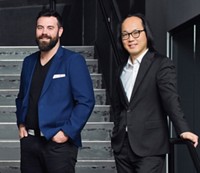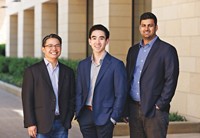Advertisement
Grab your lab coat. Let's get started
Welcome!
Welcome!
Create an account below to get 6 C&EN articles per month, receive newsletters and more - all free.
It seems this is your first time logging in online. Please enter the following information to continue.
As an ACS member you automatically get access to this site. All we need is few more details to create your reading experience.
Not you? Sign in with a different account.
Not you? Sign in with a different account.
ERROR 1
ERROR 1
ERROR 2
ERROR 2
ERROR 2
ERROR 2
ERROR 2
Password and Confirm password must match.
If you have an ACS member number, please enter it here so we can link this account to your membership. (optional)
ERROR 2
ACS values your privacy. By submitting your information, you are gaining access to C&EN and subscribing to our weekly newsletter. We use the information you provide to make your reading experience better, and we will never sell your data to third party members.
Start-ups
Clasp Therapeutics launches with $150 million in hand
Backed by Third Rock Ventures, Novo Holdings, and Catalio Capital Management, the company bets on improving an emerging anticancer modality
by Alla Katsnelson, special to C&EN
March 20, 2024

Clasp Therapeutics, a company that aims to create a next-generation version of immunoncology drugs called bispecific T cell engagers (TCEs), launched today with $150 million in series A financing.
The company’s platform, based on the work of cancer geneticist Bert Vogelstein and immune-oncologist Drew Pardoll at Johns Hopkins University, will produce off-the-shelf therapies that specifically target common oncogenes without the toxicity that currently occurs with this therapeutic modality, says Clasp CEO Robert Ross.
Bispecific TCEs act as matchmakers for destruction. They are antibody-like proteins in which one arm binds T cells, and another binds tumor cells. Bringing the two cells into close proximity activates the T cell to destroy the tumor cell. In 2018, the first TCE, blinatumomab, received US Food and Drug Administration approval to treat a specific form of acute lymphoblasticleukemia. A handful have since made it to the clinic, and several more are in clinical trials.
However, the TCEs currently used in the clinic connect with tumor cells by recognizing markers that are also expressed in normal cells, though at much lower levels. That means they can’t avoid killing healthy cells, causing so-called “on-target, off-tumor” toxicity. Clasp seeks to prevent that toxicity by instead targeting oncogenes such as p53, KRAS, and PI3 Kinase, which are central to the tumor’s oncogenicity.
Aside from their main roles, these oncogenes produce cancer specific peptides that present on the surface of the tumor cells in the context of the human leukocyte antigen (HLA) system—part of the way the body signals that tissues come from the self. “What we are targeting is the mutated peptide in the context of HLA presentation,” Ross says. “For a patient to be eligible to be treated, their tumor has to have both the mutation and the right HLA phenotype.”
The approach enables Clasp to create multiple off-the-shelf versions of the therapy for different HLA phenotypes that target specific oncogenes. Because these drugs are directed at genes that are central to tumors’ oncogenicity, patients may be less prone to developing resistance to it, Ross says.
Clasp hasn’t announced specific cancer targets, but Ross says that the company’s current focus, generally, is solid tumors. There’s also no timeline yet for human trials, he adds, though its current financing “is meant to get us to clinical data before we have to raise money again.”
CORRECTION:
This story was updated on March 21, 2024, to add Catalio Capital Management to the list of main investors.




Join the conversation
Contact the reporter
Submit a Letter to the Editor for publication
Engage with us on Twitter